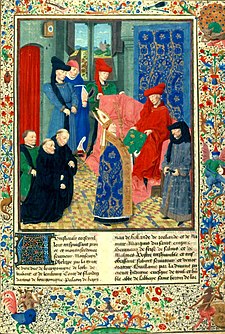
Simon Marmion was a French or Burgundian Early Netherlandish painter of panels and illuminated manuscripts. Marmion lived and worked in what is now France but for most of his lifetime was part of the Duchy of Burgundy in the Southern Netherlands.

Enguerrand Quarton was a French painter and manuscript illuminator whose few surviving works are among the first masterpieces of a distinctively French style, very different from either Italian or Early Netherlandish painting. Six paintings by him are documented, of which only two survive, and in addition the Louvre now follows most art historians in giving him the famous Avignon Pietà. His two documented works are the remarkable Coronation of the Virgin and The Virgin of Mercy. Two smaller altarpieces are also attributed to him.

The Turin-Milan Hours is a partially destroyed illuminated manuscript, which despite its name is not strictly a book of hours. It is of exceptional quality and importance, with a very complicated history both during and after its production. It contains several miniatures of about 1420 attributed to an artist known as "Hand G" who was probably either Jan van Eyck, his brother Hubert van Eyck, or an artist very closely associated with them. About a decade or so later Barthélemy d'Eyck may have worked on some miniatures. Of the several portions of the book, that kept in Turin was destroyed in a fire in 1904, though black-and-white photographs exist.

The Rothschild Prayerbook or Rothschild Hours, is an important Flemish illuminated manuscript book of hours, compiled c. 1500–20 by a number of artists. It has 254 folios, with a page size of 228 × 160 mm. It was once in the Austrian National Library in Vienna as Codex Vindobonensis S.N. 2844. Since its sale in 1999 it has held the world record price at auction for an illuminated manuscript. In 2014 it was purchased by Australian businessman Kerry Stokes from Christie's New York and is on display in the National Library of Australia.
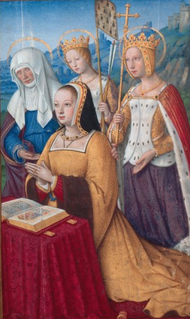
The Grandes Heures of Anne of Brittany is a book of hours, commissioned by Anne of Brittany, Queen of France to two kings in succession, and illuminated in Tours or perhaps Paris by Jean Bourdichon between 1503 and 1508. It has been described by John Harthan as "one of the most magnificent Books of Hours ever made", and is now in the Bibliothèque nationale de France as Ms lat. 9474. It has 49 full-page miniatures in a Renaissance style, and more than 300 pages have large borders illustrated with a careful depiction of, usually, a single species of plant.
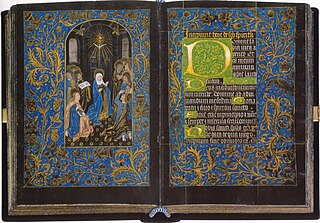
The Black Hours, MS M.493 is an illuminated book of hours produced in Bruges between 1460 and 1475, although dates as late as 1480 have been suggested. It consists of 121 leaves, most containing blocks of Latin text written in Gothic minuscule script, arranged in rows of fourteen lines. The lettering is inscribed in silver and gold, and placed within borders ornamented with flowers, foliage and grotesques, all on pages dyed a deep blueish black. It contains fourteen full-page miniatures, and opens with the months of the liturgical calendar, followed by the Hours of the Virgin, and ends with the Office of the Dead. The book follows the Roman version of the texts and has been in the collection of the Morgan Library & Museum, New York, since 1912.

The Hours of Mary of Burgundy is a book of hours, a form of devotional book for lay-people, completed in Flanders around 1477. It was probably commissioned for Mary of Burgundy, then the wealthiest woman in Europe; Mary was the only child of Charles the Bold, Duke of Burgundy and wife of Maximilian I, ruler of the Holy Roman Empire. No records survive as to its commission. The book contains 187 folios, each measuring 22.5 by 15 centimetres. It consists of the Roman Liturgy of the Hours, 24 calendar roundels, 20 full-page miniatures and 16 quarter-page format illustrations. Its production began c. 1470, and includes miniatures by several artists, of which the foremost was the unidentified but influential illuminator known as the Master of Mary of Burgundy, who provides the book with its most meticulously detailed illustrations and borders. Other miniatures, considered of an older tradition, were contributed by Simon Marmion, Willem Vrelant and Lieven van Lathem. The majority of the calligraphy is attributed to Nicolas Spierinc, with whom the Master collaborated on other works and who may also have provided a number of illustrations.

The Hours of Giangaleazzo Visconti is a Roman-liturgy illuminated Book of Hours that was commissioned by the ruler of Milan, Gian Galeazzo Visconti, in Italy in the late 14th century. A Book of Hours is a personal prayer book that contained, in part, the Hours of the Virgin, a daily devotional that was popular at the time. This particular Book of Hours was created by two master illuminators, beginning with Giovannino dei Grassi before his death, and completed by Luchino Belbello da Pavia.

Madonna in the Church is a small oil panel by the early Netherlandish painter Jan van Eyck. Probably executed between c. 1438–40, it depicts the Virgin Mary holding the Child Jesus in a Gothic cathedral. Mary is presented as Queen of Heaven wearing a jewel-studded crown, cradling a playful child Christ who gazes at her and grips the neckline of her red dress in a manner that recalls the 13th-century Byzantine tradition of the Eleusa icon. Tracery in the arch at the rear of the nave contains wooden carvings depicting episodes from Mary's life, while a faux bois sculpture in a niche shows her holding the child in a similar pose. Erwin Panofsky sees the painting composed as if the main figures in the panel are intended to be the sculptures come to life. In a doorway to the right, two angels sing psalms from a hymn book. Like other Byzantine depictions of the Madonna, van Eyck depicts a monumental Mary, unrealistically large compared to her surroundings. The panel contains closely observed beams of light flooding through the cathedral's windows. It illuminates the interior before culminating in two pools on the floor. The light has symbolic significance, alluding simultaneously to Mary's virginal purity and God's ethereal presence.
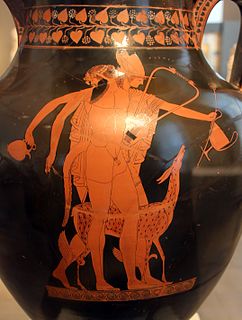
In art history, a Notname is an invented name given to an artist whose identity has been lost. The practice arose from the need to give such artists and their typically untitled, or generically titled works, an acceptable if unsatisfactory grouping, avoiding confusion when cataloging. The phrases provisional name, name of convenience and emergency names are sometimes used to describe anonymous masters; nonce name was at one time used.
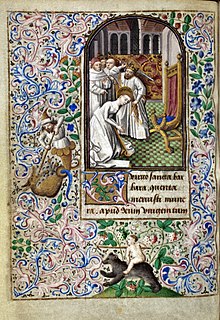
The Book of Hours of Simon de Varie is a French illuminated manuscript book of hours commissioned by the court official Simon de Varie, with miniatures attributed to at least four artists; hand A who may have been a workshop member of the Bedford Master, the anonymous illustrators known as the Master of Jean Rolin II, the Dunois Master and the French miniaturist Jean Fouquet. It was completed in 1455 and consists of 49 large miniatures and dozens of decorative vignettes and painted initials, which total over 80 decorations. Fouquet is known to have contributed six full leaf illuminations, including a masterwork Donor and Virgin diptych. A number of saints appear - Saint Simon is placed as usual alongside Saint Jude ; other pages feature saints Bernard of Menthon, James the Greater and Guillaume de Bourges.

Karl Walther was a painter of the German Post-Impressionist school, and an exponent of plein air painting. His works include portraits, still lifes, cityscapes and landscape paintings.

Madonna of the Rose Bower is a panel painting by the German artist Stefan Lochner, usually dated c 1440-42, although some art historians believe it contemporaneous with his later Dombild Altarpiece. It is usually seen as one of his finest and most closely detailed works.

Presentation of Christ in the Temple is a small 1445 painting by the German artist Stefan Lochner, now in the Gulbenkian Foundation, Lisbon. It was once the wing of a diptych, the opposite, now separated, panel was a depiction of the Nativity. Its reverse shows the Stigmatisation of St. Francis. The panel is dedicated to St. Catherine and shows the purification of the Virgin. It is the first of two of Lochner's treatments of the subject - a larger painting completed two years later is kept at the Hessisches Landesmuseum, Darmstadt, Germany. The two panels are the only known dated paintings left by Lochner.

Black books of hours are a type of luxury Flemish illuminated manuscript using pages of vellum which had been soaked with black dye or ink before they were lettered or illustrated, for an unusual and dramatic effect. The text is usually written with gold or silver ink. There are seven surviving examples, all dating from about 1455–80.
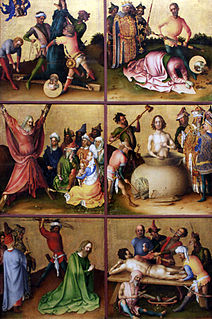
Last Judgement is a c. 1435 tempera on oak polyptych by the German artist Stefan Lochner, probably commissioned for the council chamber of City Hall of Cologne, but now broken apart. Today the outer wings, which formed a sixfold partition when extended, have been sawed off into twelve individual pictures, most of which are still extant but held in separate collections, mostly in Cologne, Munich and Frankfurt. The interior wings included the Martyrdom of the Apostles, the exterior panels comprised in part of the Saint Anthony Abbot, Mary Magdalene and a Donor, Saints Catherine, Hubert, Quirinus of Neuss, and a Donor, and Pope Cornelius. Its depiction of the Last Judgment follows many of the conventions of contemporary doom paintings, but Lochner introduces important innovations, especially in his rendering of the angel's black and flowing clothes.

Annunciation is a panel painting by the German artist Stefan Lochner, the panels were probably conceived as outer wing for a lost altarpiece. It shows the virgin, rather conventionally receiving the voice of the holy spirit, who hovers above her in the form of a dove. A vase behind her holds a lily. Her white clothes and the flower represent her virginity. It seems influenced by similar panels found in Jan van Eyck's Ghent Altarpiece.

The Master of Mary of Burgundy was a Flemish illuminator, painter and draughtsman active between 1469-1483 in Flanders, probably in Ghent. His notname is derived from two books of hours attributed to him, the Vienna Hours of Mary of Burgundy and another books of hours, now in Berlin, also for Mary of Burgundy.

The Dombild Altarpiece is a painted triptych by the German artist Stephan Lochner. Originally painted for the council-chapel St. Maria in Jerusalem in Cologne, it was moved to Cologne Cathedral in 1810 and is now in that church's Marienkapelle, south of the choir. It is also known as the Three Kings Altarpiece (Dreikönigsaltar) and the Patron Saints of Cologne Altarpiece.























